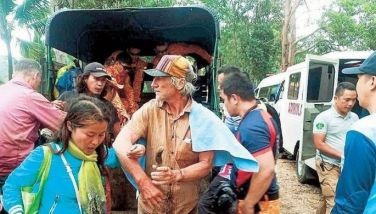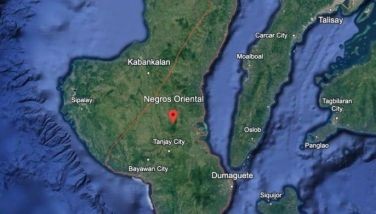Bulacan girding for ‘bio-control’ of coconut bugs
July 23, 2006 | 12:00am
MALOLOS CITY — Local agriculture officials are girding for a provincewide "bio-control" to prevent the spread of the coconut leaf beetle first detected in Manila’s Baywalk area last year.
Tina Geronimo, of the provincial agriculture office, told The STAR that they will monitor the presence of the coconut bug, whose scientific name is Brontispa longissima, in the province and disseminate information on how to control it.
This, after officials of the Philippine Coconut Authority (PCA) told participants in last Thursday’s seminar on "Biology, Damage and Management of Coconut Leaf Beetle" at the Hiyas ng Bulacan Convention Center here that they have detected the bug’s presence in Marilao and Malolos City.
Geronimo said provincial agriculture officials would urge the various local governments to pass ordinances creating a task force and putting up checkpoints to prevent the spread of the coconut leaf beetle.
The coconut bug was first detected on coconut trees lining the Baywalk area along Roxas Boulevard in Manila in April last year.
The bugs, however, are not only attacking coconut trees, but also other members of the ornamental palm family.
According to Mateo Zipagan, chairman of the PCA’s Brontispa Action Team, the bugs have spread to Laguna, Batangas, Cavite and as far as Northern Samar.
He said they have detected infestations in Marilao town and Barangay Tikay in this city.
"We suspect that the infestations in Allen, Northern Samar came from Bulacan because landscapers at the Basilica de Naga told us that the palms they brought there came from Bulacan," Zipagan said.
However, he said it is not yet conclusive since the palms brought to the Basilica de Naga stayed for a while in Los Baños, Laguna where there is also an infestation.
"What we are sure of is Bulacan is a major source of ornamental palms in the country, that is why we are trying to inform the people here," Zipagan said.
He said the bugs could be controlled with the use of insecticides, fungi and parasitoid.
Based on materials distributed by PCA officials, Hercules EC or Karate EC insecticide can be spread on the sword and spear leaves of palms in case of heavy and sporadic infestation, but PCA and DA agriculturists must closely supervise the application.
Zipagan urged though the use of fungi and the natural enemies of brontispa, including the green and white moscardin fungi that can be cultured using corn grits as well as earwigs, a kind of bug that eats the coconut leaf beetle while it is still a larva.
"The way we see it, the most effective is the use of the parasitoid small wasps (haekeliana sp.) because they eat the brontispa eggs and that means (there is no) damage on the plant yet," he said.
The PCA research center tried to culture haekeliana sp. for mass production, but it failed.
Through bio-control, Zipagan said they are not trying to totally eradicate the Brontispa longissima, but instead controlling its population to a level that is not injurious.
"This means ecological balance because when we eradicate the Brontispa longissima, it might lead to the extinction of other species that lives on (it) as their meal," he said.
Zipagan said the presence of the bug’s natural enemies only indicates that the country’s ecosystem is not yet as damaged as many have thought, unlike in Vietnam which severely suffered from Brontispa longissima infestation, relying only on artificial insecticides because its ecology has been destroyed.
Tina Geronimo, of the provincial agriculture office, told The STAR that they will monitor the presence of the coconut bug, whose scientific name is Brontispa longissima, in the province and disseminate information on how to control it.
This, after officials of the Philippine Coconut Authority (PCA) told participants in last Thursday’s seminar on "Biology, Damage and Management of Coconut Leaf Beetle" at the Hiyas ng Bulacan Convention Center here that they have detected the bug’s presence in Marilao and Malolos City.
Geronimo said provincial agriculture officials would urge the various local governments to pass ordinances creating a task force and putting up checkpoints to prevent the spread of the coconut leaf beetle.
The coconut bug was first detected on coconut trees lining the Baywalk area along Roxas Boulevard in Manila in April last year.
The bugs, however, are not only attacking coconut trees, but also other members of the ornamental palm family.
According to Mateo Zipagan, chairman of the PCA’s Brontispa Action Team, the bugs have spread to Laguna, Batangas, Cavite and as far as Northern Samar.
He said they have detected infestations in Marilao town and Barangay Tikay in this city.
"We suspect that the infestations in Allen, Northern Samar came from Bulacan because landscapers at the Basilica de Naga told us that the palms they brought there came from Bulacan," Zipagan said.
However, he said it is not yet conclusive since the palms brought to the Basilica de Naga stayed for a while in Los Baños, Laguna where there is also an infestation.
"What we are sure of is Bulacan is a major source of ornamental palms in the country, that is why we are trying to inform the people here," Zipagan said.
He said the bugs could be controlled with the use of insecticides, fungi and parasitoid.
Based on materials distributed by PCA officials, Hercules EC or Karate EC insecticide can be spread on the sword and spear leaves of palms in case of heavy and sporadic infestation, but PCA and DA agriculturists must closely supervise the application.
Zipagan urged though the use of fungi and the natural enemies of brontispa, including the green and white moscardin fungi that can be cultured using corn grits as well as earwigs, a kind of bug that eats the coconut leaf beetle while it is still a larva.
"The way we see it, the most effective is the use of the parasitoid small wasps (haekeliana sp.) because they eat the brontispa eggs and that means (there is no) damage on the plant yet," he said.
The PCA research center tried to culture haekeliana sp. for mass production, but it failed.
Through bio-control, Zipagan said they are not trying to totally eradicate the Brontispa longissima, but instead controlling its population to a level that is not injurious.
"This means ecological balance because when we eradicate the Brontispa longissima, it might lead to the extinction of other species that lives on (it) as their meal," he said.
Zipagan said the presence of the bug’s natural enemies only indicates that the country’s ecosystem is not yet as damaged as many have thought, unlike in Vietnam which severely suffered from Brontispa longissima infestation, relying only on artificial insecticides because its ecology has been destroyed.
BrandSpace Articles
<
>
- Latest
- Trending
Trending
Latest
Trending
Latest
Recommended
























